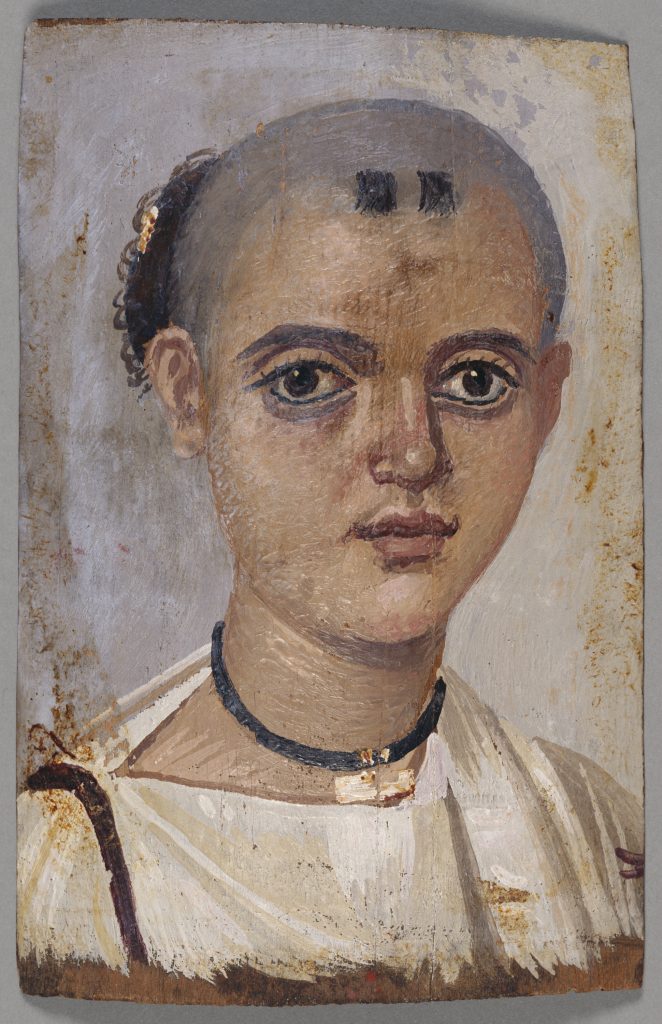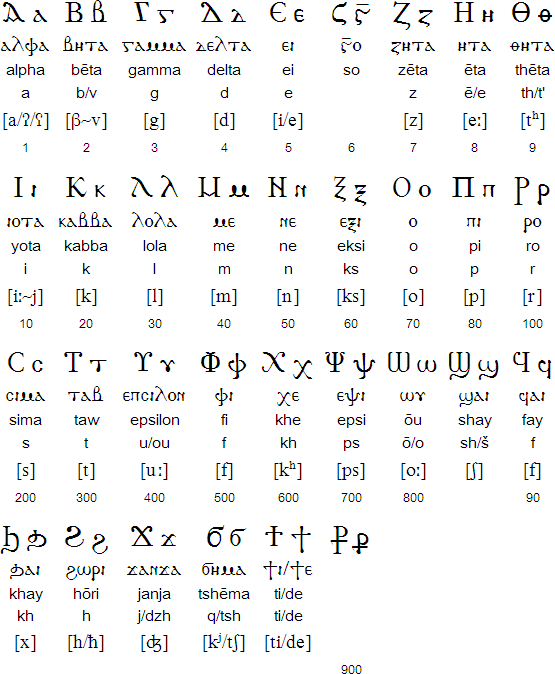
This week’s post takes a deep dive into another healing amulet from Kyprianos, our database of Coptic magical texts. This tall thin sheet of parchment, 30.5cm in height but only 4.5cm in width, was filled with an applied text, a text with the name of its client written upon it. The amulet was produced to protect a man named Mina, son of Euprepri and Zoe, from all manner of illnesses through the names and powers of Jesus Christ. Although dated by its first editor, Viktor Stegemann, to the 5th century CE, some of the ways certain words in the text are spelled suggest it could be later. The photograph of the manuscript does not show any obvious creases from where it was folded, and so it seems more likely that the long strip of parchment was instead rolled and perhaps worn in a case suspended from a necklace (as we sometimes find depicted in portraits).
The text is composed of different sections, which have been compiled together to fill the written surface. The first seven lines contain different signs (kharatēres), some clearly derived from letters of the Coptic alphabet, such as ⲇ, ⲁ, ⲛ in line 1 and ⲣ, ⲏ in line 5, others more schematic designs. Crowning the text that begins in line 8 is a cross +, flanked by two identical signs that resemble upturned ⲧ letters. Such signs are often invoked in the spells themselves as “amulets” (phylaktērion), but in this text they do not seem to be addressed.
The spell begins underneath these seven lines of signs, commencing with an invocation “in the name of your (pl.)” power”, using the Egyptian word ϭⲟⲙ, (kyom), “your (pl.) names”, and “the” powers, using the Greek word ⲧⲏⲛⲁⲙⲓⲥ (from δύναμις, dunamis). So, it seems that a plurality of beings are at first invoked, and then commanded to “give healing”. Following this, we see evidence of the fact this spell was copied from a formulary, a ‘master copy’ text into which the practitioner was supposed to insert the name of the client; the copyist initially forgot to do this, and as a result, the text first reads that healing should be given to “so-and-so the son of <so-and-so>”, before the practitioner corrected themselves and added the name of a man called Mina, the son of a man called Euprepi and a woman called Zoe. This first section then closes with the conventional formulae commanding that the healing is to be given “quickly” and “immediately”!
In the name of your (pl.) power, your (pl.) names, and the powers, you (pl.) will give healing <to> so-and-so the son of <so-and-so>, who (in this case) is Mina, the son of Euprepi, the son of Zoe, quickly, quickly! Immediately, immediately! Quickly! In the name of your (pl.) powers and your (pl.) powers, Jesus Christ, give healing, quickly, quickly! Every illness, every sickness, any type of every illness. Give healing, quickly, quickly! Jesus the Lord. Amen ⲑϥ
Vienna, Nationalbibliothek K 08635 Pap lines 8-39
The next section of the spell begins in exactly the same fashion as the first, invoking “in the name of your (pl.) power”, this time using the Greek word dunamis first, and again invoking “your (pl.)” powers, using the Coptic word kyom second. Jesus Christ is then invoked by name, and commanded to “give healing”, once again “quickly”, perhaps suggesting that it is not a plurality of beings that are invoked, but that the plural is an honorific way to refer to Jesus. Despite this being the second end formula in the text, another command follows. The amulet is then specified to be a cure all, stating that it will heal “every illness”, using the Coptic word ϣⲱⲛⲉ (shōne), and “every sickness”, using a different Coptic word ⲗⲟϫⲗⲉϫ (lojlej), as well as “any type of every illness”. It is against these afflictions that the amulet will “give healing”, and “quickly”, as is commanded one final time.

Underneath a scribal annotation, a horizontal line that divides the final section from what precedes it, is written “Jesus, the Lord. Amen. ⲑϥ.” The word used for “amen” is a Greek loanword, borrowed in turn from Hebrew: ϩⲁⲙⲏⲛ (hamēn). But it is then followed by two letters ⲑϥ. This is a reversed writing of ϥⲑ, the Coptic numeral for 99. Because the Greek letters were also used to write numbers, any word written in Greek (and Coptic, which borrowed its alphabet) could be assigned a numerical value by adding up the values of the individual letters. Numbers could be therefore used as ciphers – in this case, ϥⲑ writes amen again – ⲁ = 1, ⲙ = 40, ⲏ = 8, and ⲛ = 50, totalling 99. This kind of cipher is found both in magical manuscripts and in more mundane documentary texts.

This cipher is yet another example of the creative scribal process that has already been seen in other writings on this amulet. This text does not only show us two different words for the “powers” that were invoked, the first Coptic (kyom), the second Greek (dunamis), nor heal two different types of “cure all” illness (shone and lojlej), but it also repeats the closing formula “amen” without repeating the word itself: the first in the Coptic form (hamēn), the second the Greek form in a cipher (99). This combination of repetition and variation may well, then, have been seen to add power and potency to the series of three invocations, their commands to “give healing”, and so have helped to heal Mina from his afflictions.
Bibliography
Stegemann, Viktor. Die koptischen Zaubertexte der Sammlung Papyrus Erzherzog Rainer in Wien. Sitzungsberichte der Heidelberger Akademie der Wissenschaften. Philosophisch-historische Klasse, 1933-34 n°1. Heidelberg: Carl Winters Universitätsbuchhandlung, 1934, no. XXV (95), p. 21 and 43-44.
